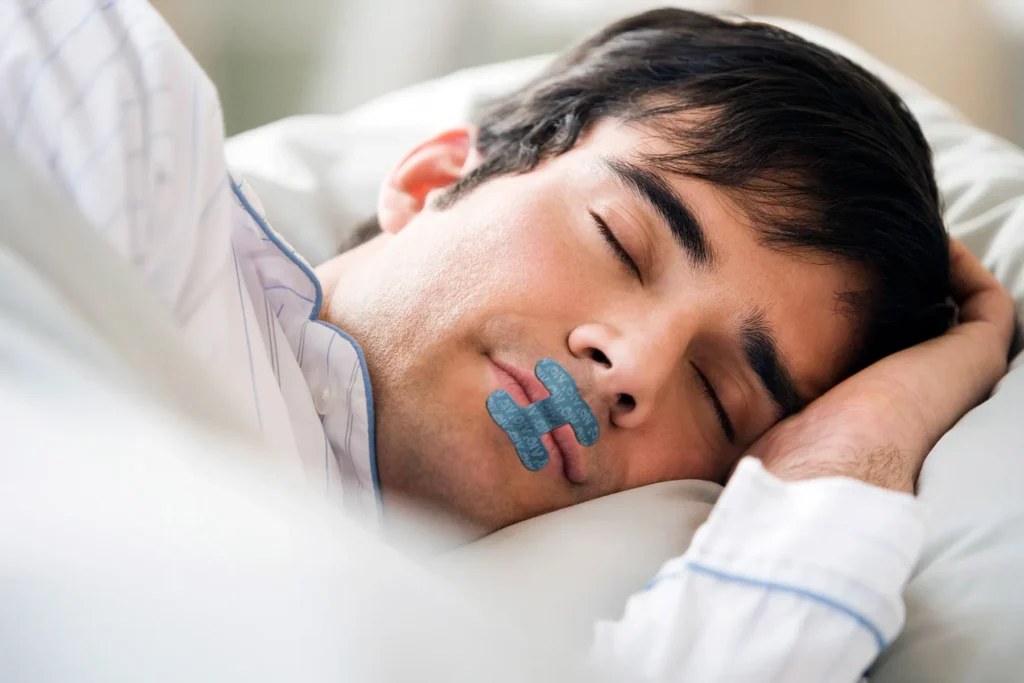Mouth taping while sleeping is a wellness trend gaining popularity on social media. People are sharing videos of themselves taping their mouths shut at night. They claim it improves sleep, reduces snoring, and even boosts energy. But does this trend have any scientific backing, or is it just another viral idea?

What Is Mouth Taping While Sleeping?
Mouth taping is exactly what it sounds like — placing a strip of medical tape over the lips before bedtime. The idea is to force nasal breathing during sleep instead of breathing through the mouth.
Although it may seem unusual, this practice is rooted in the belief that nasal breathing offers more health benefits than mouth breathing.
Why Do People Try It?
Many believe that mouth breathing while asleep can lead to snoring, dry mouth, bad breath, and even poor sleep quality. Nasal breathing, in contrast, warms and filters air better and increases nitric oxide intake, which is thought to support cardiovascular health.
As a result, influencers and some wellness coaches have encouraged mouth taping as a simple fix. They often claim it helps improve sleep and prevents waking up tired.
Potential Benefits of Mouth Taping While Sleeping
Here are the most reported advantages:
| Benefit | Explanation |
|---|---|
| Better Sleep Quality | Nasal breathing promotes deep, restorative sleep |
| Less Snoring | Mouth taping may reduce snoring frequency and volume |
| Improved Oral Health | Prevents dry mouth, cavities, and bad breath |
| Boosted Nitric Oxide Production | Nasal breathing supports nitric oxide, which improves circulation and immune defense |
| Better Jaw Positioning | Encourages proper tongue posture and may support facial development (especially in children)* |
*Note: Facial structure claims are mostly anecdotal and need more research.
Is There Any Science Behind Mouth Taping?
So far, very little clinical research has been conducted on mouth taping. However, a few small studies suggest some potential benefits.
For instance, a 2022 study published in Cureus tested mouth taping on patients with mild obstructive sleep apnea. Results showed improved nasal breathing and reduced snoring in a few participants. Nevertheless, the study had a small sample size, and more research is needed to confirm these effects.
Furthermore, the idea of promoting nasal breathing is supported by science. Nasal breathing helps humidify air and filter allergens. It also activates the diaphragm, which supports deeper and more restful sleep.
Even so, taping the mouth shut is not a proven medical solution. Experts suggest caution.
Risks and Warnings
While the trend may seem harmless, it’s not safe for everyone. Individuals with nasal congestion, sleep apnea, or breathing issues should never try mouth taping without consulting a doctor.
In addition, taping the mouth can cause anxiety or discomfort during sleep. Some people may even wake up struggling to breathe.
Always use skin-safe tape if you choose to try it. Never use duct tape or regular adhesive tapes.
What Do Experts Say?
According to Dr. Raj Dasgupta, a sleep medicine specialist, there is no strong evidence yet that mouth taping improves sleep quality. He warns that forcing the mouth shut without addressing underlying nasal problems can make sleep worse, not better.
Therefore, it’s best to consult a sleep doctor if you’re experiencing snoring or poor sleep quality. Mouth taping is not a substitute for proper diagnosis and treatment.
Alternatives to Mouth Taping
If you’re interested in improving your sleep through better breathing, there are safer alternatives to consider:
- Nasal strips or dilators: These help open the nasal passages.
- Humidifiers: They keep the air moist and reduce irritation.
- Allergy treatment: Controlling allergens can reduce nasal congestion.
- Breathing exercises: Practices like Buteyko or pranayama promote nasal breathing naturally.
These options can support healthy breathing without the risks of taping.
Final Verdict: Is Mouth Taping while sleeping Trend or Science?
Mouth taping is certainly trending, especially on platforms like TikTok and Instagram. While early findings and anecdotal stories show promise, the science is still catching up.
If you’re curious, talk to a medical professional before trying it. What works for one person may not be safe for another. Instead of following trends blindly, always prioritize safety and expert advice.

